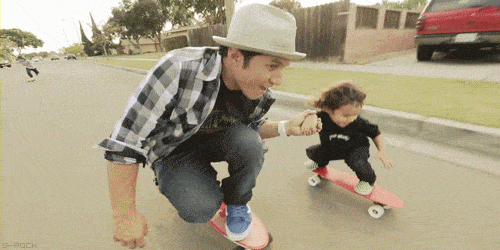You'll recognize a cinemagraph the moment you see one.
They're hypnotic, mostly still images with artistically rendered, subtle motion—kind of like the moving photographs and paintings in the Harry Potter films.
Although there are no marketing silver bullets, cinemagraphs are fairly shiny and new, and they are still rare enough to have impact on your audience.
Here's a beautiful example I couldn't stop looking at when I first saw it:
The History of Cinemagraphs
Cinemagraphs were invented in 2011 by photographer Jamie Beck and Web designer Kevin Burg for Fashion Week in New York. The response to these magical images was so overwhelmingly positive, that the pair was able to build a business around them. Fashion cinemagraphs were soon being used by heavy-hitters such as Vogue's Anna Wintour.
One of their first major commercial projects, four Instagram posts for shoe designer Stuart Weitzman, earned over 1,600 comments and 60,000 likes from fans within a few days. The content took advantage of the platform's new-at-the-time video looping feature.
Even with new developments in consumer-grade video apps, such as Instagram's Boomerang, Beck's and Burg's cinemagraphs stand out for their craft and composition. Here's a (low-resolution) GIF version of one of them:

Cinemagraph Marketing Trends
Studies have shown a significant increase in engagement when rich media is included in digital marketing tactics. According to one study featured on MarketingProfs, "72% of email marketers who have used animated gifs or cinemagraphs have recorded higher transaction-to-click rates, compared with bulk emails to the same customers."
GIFs certainly boost click rates, but the illusion of seamless and continuous movement cinemagraphs create is far less common—and they can be deployed in HD. Compare the following GIF and cinemagraph:

Cinemagraphs are particularly well suited for advertisements featured on social media platforms, such as Instagram and Facebook, that automatically start and repeat videos.
Flixel, a Shutterstock partner, did a compelling case study about a social media campaign by one of its clients, Microsoft:
- Twitter ads featuring cinemagraphs targeted at small businesses "saw an increase of 110% compared to the 1.96% increase in engagement generated by advertisements using still photos."
- On Facebook, "engagement rates increased by 85% with cinemagraph social ads, versus the 0.83% increase on still image ads."
Source: One Hope Wine
Cinemagraphs vs. GIFs
The biggest disadvantage of cinemagraphs is that it can be a challenge to make them look good: Everything from the original recording to the final color treatment has to be considered. When you make GIFs—though it does take a certain talent—you're really only choosing where to begin and end the loop.
A well-rendered cinemagraph requires a photographer's eye and a decent amount of image- and video-editing skill. The pieces that really stand out are almost always well-planned. The lighting has to be just right. The action has to be choreographed. The concept needs to be strong. If it isn't, you're in for a hard time when you get to editing. As you can imagine, this requires more time, and money, than you might have. And sometimes a GIF is good enough:

Cinemagraphs look fantastic in higher-resolution formats. The crispness and vibrancy that those formats enable can be compelling to customers; but, since it's ultimately a video, the file sizes can be huge. That makes them difficult to share and problematic to embed into some posts. You can certainly reduce the quality of the file, but it's a shame to do so if you've created something exceptional.
Feature-loaded digital asset management (DAM) tools can solve many of the common challenges associated with using video assets, such as on-the-fly size conversion. And since cinemagraphs can be relatively expensive to make or acquire, you don't want to misplace them or use them without appropriate licensing. Adding metadata to your cinemagraph assets will ensure they're always easy to find.
How to Make a Cinemagraph
- Make your own with Adobe. The best cinemagraphs tend to be created by designers who have an eye for photography and a feel for video editing. If that's you, great. There are plenty of tutorials online. As demand grows for this kind of content, it will be a valuable skill to develop. Especially while rates remain somewhat competitive.
- Hire a cinemagraph professional. This can be the most expensive option; as with anything else, you get what you pay for. However, if you have a specific concept that can't be satisfied with a stock cinemagraph or your own labor, and it needs to look polished, this is a solid option.
- Use cinemagraph software tools. Flixel, mentioned earlier, makes editing software specifically for creating high-quality cinemagraphs. You still need to have a good sense of design, but the skill barrier is reduced, speeding up the process.
- Buy an off-the-shelf cinemagraph. Many creatives are excited about the artistic possibilities offered by this relatively new medium. That means they're becoming more available on stock content sites. They tend to be pricier than still images; however, that can be an advantage—because you won't see the same image used over and over again.
- Give Shutterstock Custom a try. Our sister company combines a brand's visual style and strategy with its global network of creatives to shoot high-quality, on-brand content. One of its services is cinemagraph creation.
Now Is the Time
Cinemagraphs continue to become more popular as organizations learn how effective they can be compared with conventional still images. Even with the added production expense, you're likely to come out ahead.
In the Microsoft case study mentioned earlier, the tech giant found that "cost per engagement decreased by 45% when cinemagraphs were used in their social media ads because engagement was higher than those that included still photos." At scale, that can be a significant benefit.
Right now, cinemagraphs are intriguing. As more tools become available to make them, the cost of producing cinemagraphs should go down. When that happens, you'll likely see a huge spike in their use. However, now is the perfect time to add them to your content quiver.
They're still novel enough to catch people's attention.




